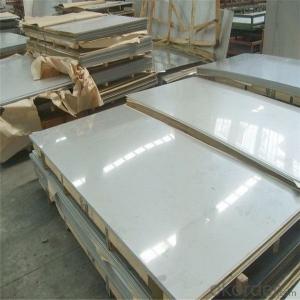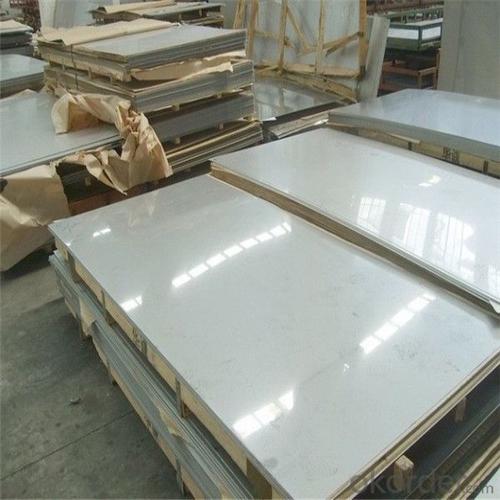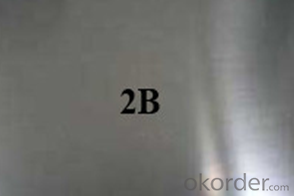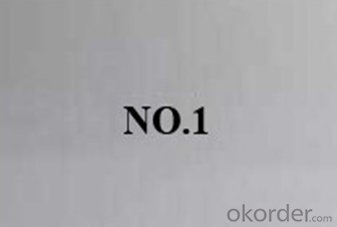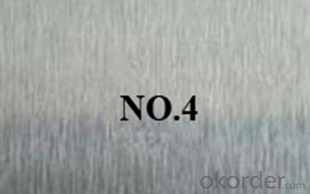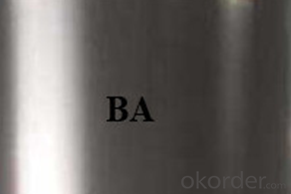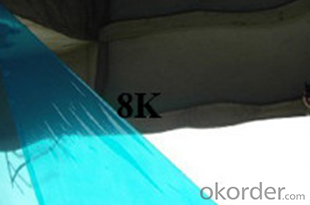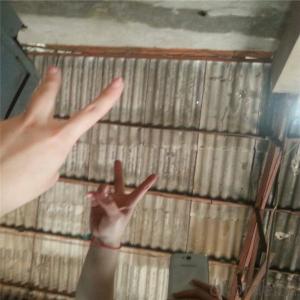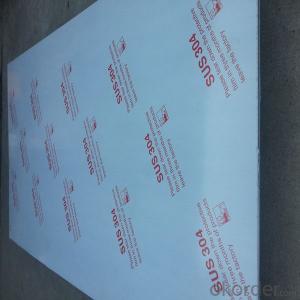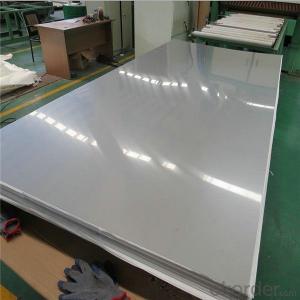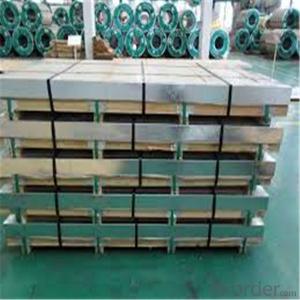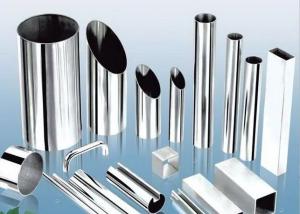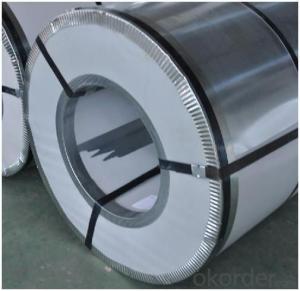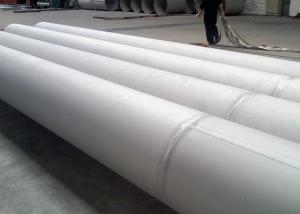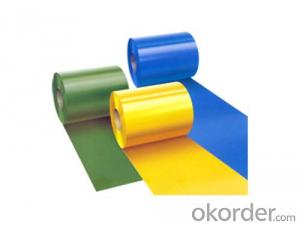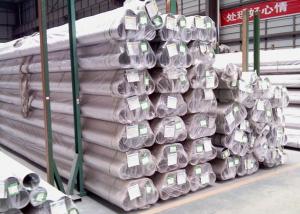321 Stainless Steel Sheet perfect price strong hardness
- Loading Port:
- Shanghai
- Payment Terms:
- TT OR LC
- Min Order Qty:
- 1 m.t.
- Supply Capability:
- 20000 m.t./month
OKorder Service Pledge
OKorder Financial Service
You Might Also Like
Specification
perfect price strong hardness 321 stainless steel sheet
Product Description
specification information of stainless steel sheet 321
| Type | stainless steel sheet 321 |
| Thickness | 0.4-6mm |
| Width | 1000mm,1219mm,1250mm |
| Length | 1000-6000mm or as customers' request |
| Standard | AISI,ASTM,EN,BS,DIN,JIS,etc |
| Material | 321 |
| Surface | 2B,BA,No.4,BH,BA,polishing 8K |
| Brand name | TISCO,ZPSS,LISCO |
| Packaging Standard | export sea-worthy package,covered with PVC,and wooden case,or customize package |
| Technique | cold rolled |
| Delivery time | Within 7-10 days after receive your 30% desipot or as your requirement |
| Supply ability | 1000 metric tons/Month |
| Payment terms | L/C,T/T(30% desipot) |
| Application | range plate heat exchanger,corrugated pipe,household articles,building materials,chemical,food industry,agriculture,marine parts,etc. |
| note | we accept orders according to customers' requirement as well as processing on given materials |
surface finish
Surface | Picture | Features |
2B |
| The surface brightness and flatness of2B is better than 2D. Then through a Special surface treatment to improve its mechanical properties, it could nearly satisfy comprehensive uses. |
No.1 |
| Polished with abrasive belt of grit#100-#200,have better brightness with Discontinuous coarse stria, used As inner and external ornaments for building,electrical appliances and kitchen utensils etc. |
No.4 |
| Polished with abrasive belt of grit #150#180,have better brightness with discontinuous coarse stria, but thinner than No3, are used as bathtub buildings inner and external ornamentselectrical appliances kitchen utensils and food processing equipment etc. |
HL |
| Polished with abrasive belt of grit #150#320 on the NO.4 finish and has continuous streaks,mainly used as buildings ornaments elevators, door of building, frontal plate etc. |
BA |
| Cold rolled, bright annealed and skin-passed,the product have excellent brightness and good reflexivity like mirror, kitchen apparatus,ornament etc. |
8k |
| The product have excellent brightness and prefer reflexivity can to be the mirror. |
chemical composition
Grade | C (%) | Mn (%) | P (%) | S (%) | Si (%) | Cr (%) | Ni (%) | Mo (%) | Nitrogen (%) | Cu/ Others |
301 | ≤0.15 | ≤2 | ≤0.045 | ≤0.03 | 1 | 16.00 - 18.00 | 6.00 - 8.00 | - | ≤0.1 | - |
304 | ≤0.08 | ≤2 | ≤0.045 | ≤0.03 | 1 | 18.00 - 20.00 | 8.00- 10.50 | - | ≤0.1 | - |
304L | ≤0.03 | ≤2 | ≤0.045 | ≤0.03 | 1 | 18.00 - 20.00 | 8.00- 12.00 | - | ≤0.1 | - |
310S | ≤0.08 | ≤2 | ≤0.045 | ≤0.03 | 1.5 | 24.00- 26.00 | 19.00-22.00 | - | - | - |
316 | ≤0.08 | ≤2 | ≤0.045 | ≤0.03 | 1 | 16.00 - 18.00 | 10.00- 14.00 | 2.00 - 3.00 | ≤0.1 | - |
316L | ≤0.03 | ≤2 | ≤0.045 | ≤0.03 | 1 | 16.00 - 18.00 | 10.00- 14.00 | 2.00 - 3.00 | ≤0.1 | - |
317 | ≤0.08 | ≤2 | ≤0.045 | ≤0.03 | 0.75 | 18.00 - 20.00 | 11.00 - 14.00 | 3.00 - 4.00 | ≤0.1 | - |
321 | ≤0.08 | ≤2 | ≤0.045 | ≤0.03 | 0.75 | 17.00 - 19.00 | 9.00 - 12.00 | - | ≤0.1 | Ti5xC Min |
Applications
Be extensively applied to architectural decoration, such as elevator decoration, luxurious doors, outdoor projects, wall decoration, advertisement nameplates, sanitary ware, ceiling, corridor, hotel hall, shop facade.Kitchenware, food industry, electronic industry, medical equipment, etc.
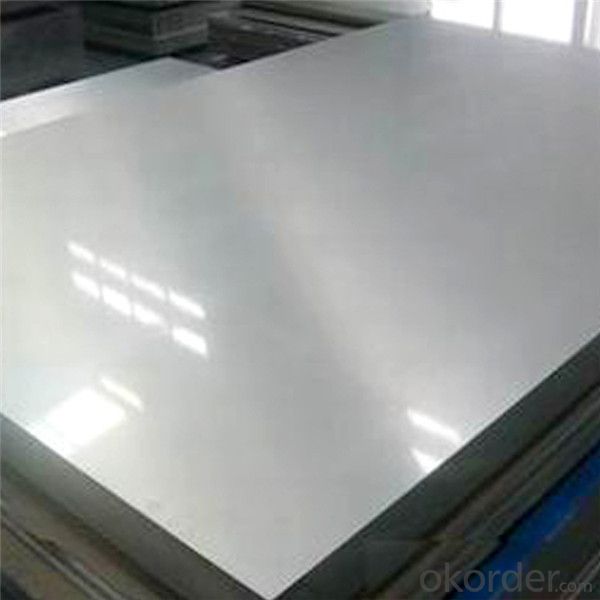
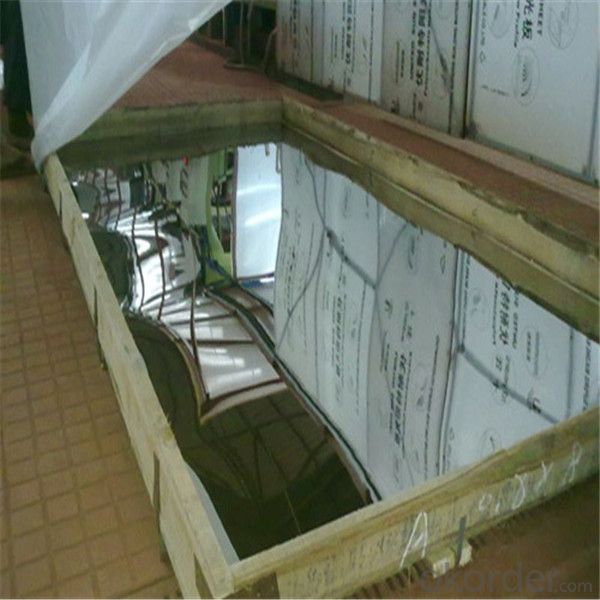
- Q: Can stainless steel sheets be used for beer tanks?
- Indeed, beer tanks can utilize stainless steel sheets. The durability, corrosion resistance, and hygienic characteristics of stainless steel make it a prevalent material choice for beer tanks. To safeguard the quality of the beer and prevent contamination, stainless steel sheets are frequently employed in crafting the walls and inner surfaces of beer tanks. These sheets can be skillfully fabricated and welded together to form a seamless tank that can endure the pressure and temperature demands of the brewing procedure. Furthermore, stainless steel is effortlessly cleaned and maintained, rendering it an impeccable material for beer tanks.
- Q: Can stainless steel sheets be used for storage containers?
- Yes, stainless steel sheets can be used for storage containers. Stainless steel is a durable and corrosion-resistant material, making it suitable for storing various items safely and maintaining their integrity.
- Q: Are stainless steel sheets suitable for chemical transport containers?
- Indeed, chemical transport containers can rely on stainless steel sheets. Renowned for its exceptional resistance to corrosion, stainless steel proves highly appropriate for chemical transportation. Its ability to withstand numerous acids, alkalis, and corrosive substances guarantees the preservation and purity of the chemicals throughout transit. Moreover, stainless steel sheets boast durability and strength, delivering structural integrity to the containers and ensuring the secure transportation of chemicals.
- Q: What are stainless steel sheets used for?
- Stainless steel sheets are commonly used in various industries and applications, including construction, automotive, aerospace, food processing, and medical equipment manufacturing. They are primarily utilized for their exceptional resistance to corrosion, durability, and aesthetic appeal. Stainless steel sheets are employed in the production of architectural components, kitchen appliances, storage tanks, machinery parts, and decorative items, among others.
- Q: Are stainless steel sheets resistant to heat and high temperatures?
- Stainless steel sheets possess exceptional resistance to heat and high temperatures. Their remarkable heat resistance properties enable them to maintain both their strength and structural integrity even under extreme temperature conditions. Consequently, stainless steel sheets are highly suitable for a diverse range of applications that involve heat and high temperatures. These applications include industrial furnaces, boilers, heat exchangers, and automotive exhaust systems. Stainless steel is capable of enduring temperatures of up to 1200 degrees Celsius (2192 degrees Fahrenheit) without compromising its structural properties, rendering it a favored option in industries requiring materials that can withstand intense heat. Furthermore, stainless steel also exhibits excellent resistance to oxidation, thereby preventing the formation of rust or scale when exposed to high temperatures for extended durations. In sum, stainless steel sheets serve as an exceptional choice for applications necessitating resistance to heat and high temperatures.
- Q: What are the different sizes available for stainless steel sheets?
- Stainless steel sheets come in a wide variety of sizes to meet different requirements and applications. The most commonly used sizes for stainless steel sheets are typically 4 feet by 8 feet (1219mm x 2438mm) and 4 feet by 10 feet (1219mm x 3048mm), which are widely used in construction, architecture, and industrial settings. However, smaller sizes of stainless steel sheets are also available, such as 2 feet by 4 feet (609mm x 1219mm) or even smaller. These smaller sizes are commonly used for DIY projects, hobbyists, and smaller-scale applications. On the contrary, larger sizes of stainless steel sheets are available for specific purposes. These can include sheets that measure up to 5 feet by 10 feet (1524mm x 3048mm) or even larger. These larger sizes are often used in specialized industries like shipbuilding, oil and gas, or manufacturing. It is important to note that the thickness of stainless steel sheets can vary independently of their size, as different applications may require different thicknesses. Common thicknesses range from 0.025 inches (0.64mm) to 0.1875 inches (4.76mm) or even thicker for specialized applications. In summary, the availability of stainless steel sheets in various sizes allows for flexibility and customization according to the specific needs of a project, whether it is a small DIY project or a large-scale industrial application.
- Q: Are stainless steel sheets available in different thicknesses?
- Yes, stainless steel sheets are available in different thicknesses. Stainless steel sheets come in a variety of thicknesses ranging from very thin to thick. Common thicknesses for stainless steel sheets used in various applications include 0.4mm, 0.5mm, 0.8mm, 1mm, 1.2mm, 1.5mm, 2mm, 2.5mm, 3mm, 4mm, 5mm, 6mm, 8mm, 10mm, 12mm, and even thicker. The specific thickness required will depend on the intended use and the structural or aesthetic requirements of the project. Different thicknesses of stainless steel sheets offer varying levels of strength, durability, and resistance to corrosion.
- Q: Can stainless steel sheets be used for architectural façades?
- Yes, stainless steel sheets can be used for architectural façades. Stainless steel is a durable and versatile material that offers many advantages for façade applications. It is resistant to corrosion, weathering, and staining, making it an ideal choice for exterior use. Stainless steel sheets can be fabricated into various shapes and sizes, allowing for a wide range of design options. Additionally, stainless steel can be finished in different ways, such as brushed, polished, or colored, providing further aesthetic possibilities. Its strength and rigidity also make it suitable for large-scale installations. Overall, stainless steel sheets offer durability, aesthetic appeal, and design flexibility, making them a popular choice for architectural façades.
- Q: Is the cold rolled steel plate good or the stainless steel plate?
- Although it is impossible to provide specific parameters to prove, in fact, most stainless steel plates are used in oven making. Corrosion resistant, easy to clean, safe and sanitary.
- Q: Are stainless steel sheets suitable for aerospace applications?
- Yes, stainless steel sheets are commonly used in aerospace applications due to their excellent strength, corrosion resistance, and high-temperature capabilities. These sheets are suitable for various components such as aircraft bodies, engine parts, and structural elements, ensuring reliable performance and durability in demanding aerospace environments.
Send your message to us
321 Stainless Steel Sheet perfect price strong hardness
- Loading Port:
- Shanghai
- Payment Terms:
- TT OR LC
- Min Order Qty:
- 1 m.t.
- Supply Capability:
- 20000 m.t./month
OKorder Service Pledge
OKorder Financial Service
Similar products
Hot products
Hot Searches
Related keywords
